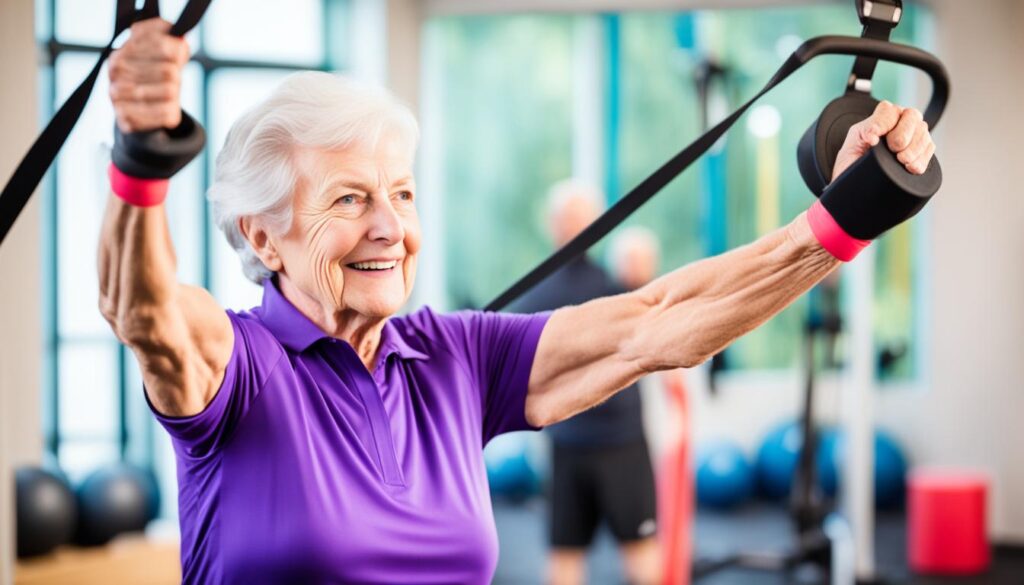Are you ready to beat the effects of aging? Do you want to keep strong and full of energy later in life? The key is strength training. As we get older, our muscles start to shrink.
This natural process is called sarcopenia. It makes us weaker and less mobile. But the good part is that strength training fights this muscle loss well, keeping you independent and strong.
Key Takeaways
- Understand the science behind sarcopenia and how strength training can prevent it
- Discover the numerous benefits of strength training for seniors, including increased muscle mass, improved bone density, and better balance
- Learn how to get started with a strength training routine, including the essential equipment and exercises
- Explore the importance of proper nutrition and recovery for muscle growth and maintenance
- Gain inspiration from successful seniors who have transformed their fitness through strength training
Why Strength Training is Crucial as You Age
As we age, we lose muscle and strength which is called sarcopenia. This muscle loss can lead to less movement, needing more help, and a higher chance of falling. But, getting older doesn’t mean we have to be less active.
Understand the Science Behind Sarcopenia
Several things cause sarcopenia, like changes in hormones, less activity, and fewer proteins. Our bodies make less growth hormone and testosterone as we age, both key for muscle health. Not being active makes things worse faster.
Debunking Myths About Aging and Exercise
Some seniors think they’re too old to start strength training or to get their muscle back. Yet, studies show that you can build and keep muscle with strength training as you get older. It’s the best way to fight sarcopenia and get in better shape.
Strength training is a crucial component of any fitness regimen for older adults, as it helps to counteract the effects of sarcopenia and maintain independence and quality of life.
Adding strength activities to their week can help seniors get stronger and improve their balance, flexibility, and how they move. This can mean a smaller chance of falling moving better, and enjoying life more.

Don’t buy into the myth that getting older means we get weaker and can’t do strength training. With the right help, seniors can see a lot of good from doing strength exercises. They can keep doing things on their own and feel better as they get older.
The Benefits of Strength Training for Seniors
As we grow older, our bodies naturally lose muscle and strength. This is due to a process known as sarcopenia. But, regular weight lifting for older adults can lessen this muscle loss and offer many benefits. By challenging your muscles with weight, you promote muscle fiber growth and reduce sarcopenia. This way, you can stay strong as you age.
Increased Muscle Mass and Strength
Lifting weights in retirement helps you maintain and build muscle mass. With age, our muscle fibers get smaller, leading to weaker and less mobile bodies. Strength training turns this around, giving you more muscle and strength. It makes daily tasks like carrying groceries easier and less stressful.
Improved Bone Density and Balance
Strength training also boosts bone density, lowering the risk of osteoporosis and fractures. Exercises like squats and lunges make your bones denser and stronger. They also enhance balance and stability reducing fall risks and boosting your physical well being.

Strength training is a game-changer for seniors. It’s not just about building muscle – it’s about reclaiming your independence, improving your quality of life, and staying strong as you age. – Jane Doe, Certified Fitness Trainer
You lose muscle mass as you age Make up for it by doing strength training
As we get older it’s normal to lose muscle mass, a process known as muscle atrophy. This can make it hard to stay strong and fit. But, there’s a way out: strength training.
Doing exercises like lifting weights can slow down muscle loss because it helps grow and maintain muscle fibers. This way, your muscles fight back against getting weaker as you age.
Strength training keeps your current muscle and even adds new muscle. This lets you keep being active and independent as you get older. Adding resistance exercises to your workouts can change how you look and feel.
| Benefits of Strength Training for Seniors | Impact on Muscle Mass and Strength |
|---|---|
| Increased muscle mass and strength | Offsets age-related muscle atrophy |
| Improved bone density and balance | Enhances mobility and reduces fall risk |
| Enhanced cardiovascular health | Boosts overall fitness and well-being |
Don’t let aging slow you down. With the power of strength training, you can keep your muscle mass intact. You can also stay strong and independent as you get older.
Strength training is the fountain of youth. It’s the closest thing we have to a magic bullet when it comes to healthy aging.
Getting Started with a Strength Training Routine
Starting a strength training for seniors journey might feel hard. But, with the right way, building muscle after 60 and getting fitter is possible. Begin slowly and up the challenge as you get used to it. It’s important to have the right equipment for building muscle after 60, whether you work out at home or at the gym.
Essential Equipment for Home or Gym
You don’t have to buy a whole home gym to start your fitness for baby boomers routine. Simple equipment is enough. For example:
- Resistance bands: These tools are great and not too pricey. They let you do many different muscle exercises.
- Dumbbells: With some light to medium dumbbells, you can do a lot. You can do exercises like bicep curls and shoulder presses.
- Bodyweight exercises: Using only your body weight, you can do simple yet powerful exercises. These include push-ups, squats, and lunges.
As you keep at it, you may want to add more tools. You could get things like kettlebells, resistance machines, or a weight bench. But always start with items you feel comfortable with. Then, slowly push yourself more.

Strength training is a game-changer for older adults looking to maintain their independence and quality of life. By building muscle and improving balance, it can help prevent falls and keep you active for years to come.
It’s wise to see a personal trainer or physical therapist if you’re new to building muscle after 60. They can guide you in making a plan that’s safe and right for you.
Resistance Exercises to Build Muscle After 60
Building muscle as we get older becomes more and more important. You can keep your muscles strong by doing resistance exercises. These include weight lifting and strength training. They help us stay active and independent as we age.
For people over 60, these resistance exercises work very well:
- Squats are great for the lower body. They help with leg strength and balance.
- Deadlifts help build muscle in your back, hips, and legs. They also make your grip stronger.
- Pushups strengthen the chest, shoulders, and triceps. You can make them easier or harder based on your fitness level.
- Pull-ups and lat pulldowns are good for the back and biceps. They balance the work your front muscles do.
- Overhead Presses build muscle in your shoulders, arms, and core. They’re great for your upper body strength.
Starting with lighter weights and the right form is crucial to avoid injury. Then, as you get stronger, you can use heavier weights. Or you can try more challenging exercises. Doing strength training often keeps your muscles strong and lets you live independently longer.

The key to building and maintaining muscle as you age is to consistently challenge your body with a variety of resistance exercises. Start light, focus on form, and gradually increase the intensity over time.
Nutrition for Muscle Growth and Recovery
Eating right is key for building and repairing muscles, especially as you get older. Choosing nutrient-packed foods helps fight off sarcopenia, which is the loss of muscle mass and strength with age.
Protein Intake for Seniors
Getting plenty of top-notch protein is vital. This helps your body create new muscle proteins and keeps the muscle you have. Seniors should try to eat 1.2-1.5 grams of protein per kilogram of body weight each day. It’s best to enjoy protein with several meals daily.
What are some great protein sources for older folks? Let’s take a look:
- Lean meats, like chicken, turkey, and fish
- Eggs
- Dairy items, such as milk, yogurt, and cheese
- Plant-based proteins, including legumes, nuts, and soy
But it’s not just protein that matters. You also need the right amount of carbs and healthy fats. They help your muscles grow and keep you healthy overall.
| Nutrient | Importance for Muscle Growth and Recovery |
|---|---|
| Protein | Stimulates muscle protein synthesis, helps maintain lean muscle mass |
| Carbohydrates | Provide energy for muscle growth and repair, support recovery |
| Healthy Fats | Promote hormone production, support joint health, and reduce inflammation |
A diet full of various, nutritious foods is the way to go. It supports the efforts you put into strength training. This way, you can keep your muscles in good shape as you get older.

Proper nutrition is essential for supporting muscle growth and recovery, especially as you get older.
Staying Motivated and Consistent
Regular strength training can be hard, especially as you get older. But, it’s vital for keeping your muscles strong as a senior. The trick is to find ways that keep you focused, inspired, and on track.
Setting achievable goals helps a lot. Take your big fitness dreams and break them into smaller, doable steps. Celebrating each step forward boosts your excitement and keeps you moving, even on tough days.
Finding fun in your workouts is just as crucial. Try new exercises, workout with a friend, or mix up your routine to keep it exciting. This makes sure you don’t get bored and that you keep up your fitness for seniors plan.
Don’t forget to track your progress. Seeing how your strength grows, your movements get easier, and your balance improves will motivate you. It shows your effort is paying off and pushes you to keep going.
The secret of getting ahead is getting started. The secret of getting started is breaking your complex overwhelming tasks into small manageable tasks, and then starting on the first one. – Mark Twain
It’s key to always work on staying motivated and consistent. With a positive attitude, rewarding your progress, and enjoying the journey, you can reach your strength training goals. Plus, you’ll keep enjoying a healthy, active life as you grow older.
Modifications for Different Fitness Levels
Tailoring your strength training is key. It’s important to match your workout to your fitness level. Whether you’re just starting, have been working out a bit, or are very experienced, there are ways to adjust your workout. These modifications help you stay safe and see the best results.
Beginner Workouts
Are you new to strength training? Start with exercises that use just your body. This helps you learn the right movements and builds a strong base. Try squats, lunges, and pushups without weights at first. Once you’re feeling confident, you can add light dumbbells or use resistance bands to up the challenge.
Intermediate Workouts
Already comfortable with the basics? Move on to more advanced exercises. These include squats, deadlifts, and overhead presses with extra weight. Also, you can increase how much and how often you lift. This keeps your muscles growing.
Advanced Workouts
If you’re pretty fit, it might be time to change things up. Try adding more dynamic exercises, like box jumps or plyo pushups, to your routine. These help build power and test your abilities. Of course, always start with the proper techniques and use less weight if needed.
It’s all about listening to your body. Start where you find it challenging but doable. Then, with time, you can level up. By doing this, you’ll build muscle, burn more calories, and stay fit for the long haul.

Preventing Injuries and Listening to Your Body
As we get older, it’s very important to avoid injuries. We should listen to our bodies well when we exercise. This helps keep us safe and fit as we age.
Starting with small weights is key to staying injury-free. It’s important to focus on how we do exercises right from the start. As we get better, we can slowly use heavier weights.
It’s also really important to notice what our bodies tell us. This can be warning signs like tired muscles or sore joints. If our bodies need a break, we should listen and rest.
- Prioritize proper form over heavy weights to prevent injuries
- Gradually increase the intensity of your workouts to build strength safely
- Take rest days when your body needs it to allow for recovery and regeneration
By watching our limits and adjusting as needed, we can keep growing stronger. This lets us stay healthy as we enjoy exercise through the years. It’s all about listening and taking care of ourselves.
Listening to your body is the foundation of a sustainable fitness journey. It’s not about pushing yourself to the brink, but rather finding the right balance between challenge and self care.
Remember, finding a balance is key to staying injury-free. It’s about challenging ourselves while also being smart about it. By following this advice, we’ll be ready for a bright, active future.

Success Stories Inspiring Seniors Who Lift
Across the nation, elders are finding new strength in strength training. Some are hitting the weights in their eighties. Others are building impressive muscles in their seventies. This shows us that getting strong has no age limit.
Meet Joan Smith. She started lifting at 75, fighting osteoporosis and weaker bones. Her local gym became her new favorite spot. With time, she lifted over 150 pounds. This made her feel strong and confident again.
Strength training has given me a new lease on life. I feel stronger, more agile, and more independent than I have in years. It’s never too late to start.
Then there’s Bob Johnson, a 72-year-old with a football past. He recently entered his first bodybuilding contest. Judges couldn’t ignore his strong, defined body. Bob’s story shares a lesson: never doubt weight lifting and strength training as you age.
These stories of seniors who lift stand out for a reason. They break the myth that growing old means you must grow weak. By being active and strong, they inspire change in others too.
Combining Strength Training with Other Activities
When keeping fit as a senior, strength training is key. But it’s vital to mix in other activities too. This makes sure you’re taking care of your whole body and mind. With this mix, you can tackle every part of staying fit and keeping up with life.
Adding activities like walking, swimming, and gentle aerobics is great for your heart and flexibility. They also boost your balance and help ward off issues like osteoporosis. Mixing up your routine keeps your body guessing. It makes exercising fun and challenging at the same time.
Doing a variety of activities also keeps you eager and ward off boredom. Trying new exercises and switching your routine keeps both your body and mind fresh. This way, you don’t lose interest and stick with your fitness plan over time.
Unlocking the Synergy of Strength Training and Complementary Activities
The perfect fitness mix for seniors is all about balance. Mixing strength training with other exercises enriches your health journey. This combo helps you live well in your golden years.
- Combine strength training with low-impact cardio like walking or swimming to improve cardiovascular health and endurance.
- Incorporate flexibility and balance exercises, such as yoga or Tai Chi, to enhance mobility and reduce the risk of falls.
- Explore activities that challenge your mind and body, like dance or Pilates, to keep your workouts engaging and fun.
Enjoyment and consistency are the real keys to senior fitness. By trying out different activities, you can make a fitness plan that meets your needs. This helps you stay healthy and independent as you get older.
Variety is the spice of life, and it’s also the key to a balanced fitness routine. By incorporating different activities, you can challenge your body in new ways and keep your workouts engaging and enjoyable.
Conclusion
You can fight age-related muscle loss with strength training. This battle is winnable. By knowing more about sarcopenia and what fitness for seniors truly involves, you can lead on health. You’ll keep your independence as the years go by.
Starting or fine tuning your strength training is all about finding the right program. Every senior’s needs and fitness level are unique. Use the correct resistance exercises and eat well. Stay motivated and consistent. This helps you beat muscle loss and weakness as you age.
Don’t let sarcopenia take away your energy and movement. Choose the power of strength training. It offers a future of more muscle, better balance, and the courage to face any test. Your best times are yet to come. So, start and keep lifting!





